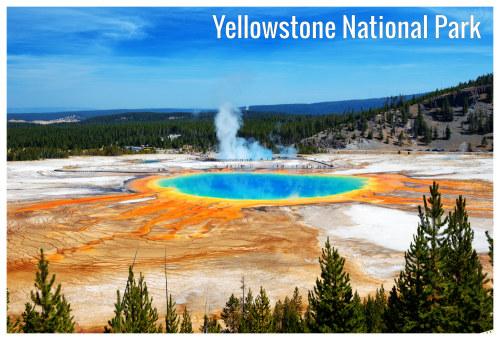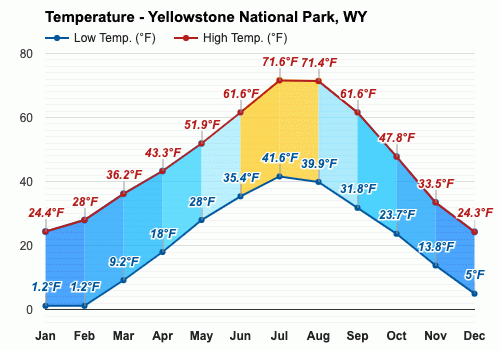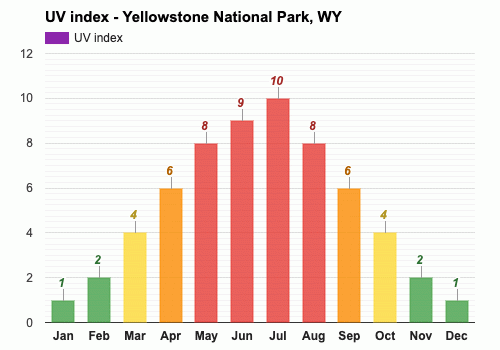
March
Weather in March
Temperature
With the onset of March, Yellowstone National Park's average high-temperature experiences a slight rise, moving from February's freezing cold 28°F (-2.2°C) to a wintry 36.1°F (2.3°C). In Yellowstone National Park, a significant divergence from daytime highs is recorded, with average lows of 9.1°F (-12.7°C) during March nights.Rainfall
In Yellowstone National Park, in March, it is raining for 13.7 days, with typically 1.81" (46mm) of accumulated precipitation. Throughout the year, there are 151 rainfall days, and 20.91" (531mm) of precipitation is accumulated.Snowfall
January through June, September through December are months with snowfall. In Yellowstone National Park, in March, snow falls for 12.6 days, with typically accumulated 25.59" (650mm) of snow. Throughout the year, in Yellowstone National Park, there are 91.4 snowfall days, and 193.7" (4920mm) of snow is accumulated.Daylight
In Yellowstone National Park, the average length of the day in March is 11h and 58min.On the first day of March, sunrise is at 6:57 am and sunset at 6:11 pm MST. On the last day of the month, sunrise is at 7:03 am and sunset at 7:49 pm MDT.
Note: On Sunday, March 10. 2024, at 2:00 am, Daylight Saving Time starts, and the time zone changes from MST to MDT. Daylight Saving Time lasts until Sunday, November 3. 2024, at 2:00 am; consequently, the time zone reverts from MDT to MST.
Sunshine
The average sunshine in March is 8h.UV index
In March, the average daily maximum UV index in Yellowstone National Park is 4. A UV Index estimate of 3 to 5 represents a medium vulnerability from exposure to the Sun's UV radiation for the average person.Note: A maximum high daily UV index of 4 during March translates into the following directions:
Act with care - The suggestion to avoid sunburn is emphasized. Midday is when the Sun's radiation is strongest; avoid prolonged exposure during this time. Sunglasses that guard against UVA and UVB rays are pivotal in minimizing sun-induced ocular damage. Forewarned is forearmed! The Sun's UV radiation can be almost doubled in intensity by snow reflection.
Published by: Weather U.S. | About Us
Data Sources | Weather Forecasting & Climate
Frequently asked questions
How cold is March?
How much does it rain in March?
How many days does it snow in March?
How many hours of daylight does Yellowstone National Park have in March?
When is the sunrise / sunset in March?
When does Daylight Saving Time (DST) start in March?
How many hours of sunshine does Yellowstone National Park have in March?
How high is the UV index in March?

Average temperature in March
Yellowstone National Park, WY
- Average high temperature in March: 36.2°F
The warmest month (with the highest average high temperature) is July (71.6°F).
The month with the lowest average high temperature is December (24.3°F).
- Average low temperature in March: 9.2°F
The month with the highest average low temperature is July (41.6°F).
The coldest months (with the lowest average low temperature) are January and February (1.2°F).

Average rainfall in March
Yellowstone National Park, WY
- Average rainfall in March: 1.8"
The wettest month (with the highest rainfall) is May (2.5").
The driest month (with the least rainfall) is October (1.2").

Average rainfall days in March
Yellowstone National Park, WY
- Average rainfall days in March: 13.7 days
The month with the highest number of rainy days is January (16.8 days).
The month with the least rainy days is October (8.8 days).

Average snowfall in March
Yellowstone National Park, WY
- Average snowfall in March: 25.6"
The month with the highest snowfall is January (34.3").
The months with the least snowfall are July and August (0").

Average snowfall days in March
Yellowstone National Park, WY
- Average snowfall days in March: 12.6 days
The month with the highest number of snowfall days is January (16.2 days).
The months with the least snowfall days are July and August (0 days).

Average daylight in March /
Average sunshine in March
Yellowstone National Park, WY
- Average daylight in March: 12h and 0min
The month with the longest days is June (Average daylight: 15h and 30min).
The month with the shortest days is December (Average daylight: 8h and 54min).
- Average sunshine in March: 8h
The month with the most sunshine is July (Average sunshine: 11h).
The month with the least sunshine is December (Average sunshine: 4h).

Average UV index in March
Yellowstone National Park, WY
- Average UV index in March: 4
The month with the highest UV index is July (UV index 10).
The months with the lowest UV index are January and December (UV index 1).